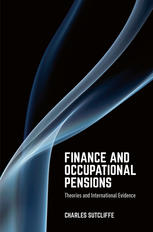

Most ebook files are in PDF format, so you can easily read them using various software such as Foxit Reader or directly on the Google Chrome browser.
Some ebook files are released by publishers in other formats such as .awz, .mobi, .epub, .fb2, etc. You may need to install specific software to read these formats on mobile/PC, such as Calibre.
Please read the tutorial at this link: https://ebookbell.com/faq
We offer FREE conversion to the popular formats you request; however, this may take some time. Therefore, right after payment, please email us, and we will try to provide the service as quickly as possible.
For some exceptional file formats or broken links (if any), please refrain from opening any disputes. Instead, email us first, and we will try to assist within a maximum of 6 hours.
EbookBell Team

4.8
64 reviewsOccupational pensions are major participants in global financial markets with assets of well over $30 trillion, representing more than 40% of the assets of institutional investors. Some occupational pension funds control assets of over $400 billion, and the largest 300 occupational pension funds each have average assets of over $50 billion. The assets of UK pension funds are equivalent to UK GDP, and US pension fund assets are 83% of US GDP. These statistics highlight the importance of pension funds as major players in financial markets, and the need to understand the behaviour of these large institutional investors. Occupational pensions also play an important, but neglected, role in corporate finance. For example, US company pension schemes account for over 60% of company market value, and yet they are often ignored when analysing companies.
This book is based on the substantial body of evidence available from around the world on a topic that has become increasingly important and controversial in recent years. Written for practitioners, students and academics, this book brings together and systematizes a very large international literature from financial economists, actuaries, practitioners, professional organizations, official documents and reports. The underlying focus is the application of the principles of financial economics to occupational pensions, including the work of Nobel laureates such as Merton, Markowitz, Modigliani, Miller and Sharpe, as well as Black. This book will give readers an up-to-date understanding of occupational pensions, the economic issues they face, and some suggestions of how these issues can be tackled. The first section explains the operation of defined benefit and defined contribution pensions, along with some descriptive statistics. The second section covers selected aspects of occupational pensions. The focus of these first two sections is on the economic and financial aspects of pensions, accompanied by some basic information on how they operate. This is followed by three further sections that analyse the investment of pension funds, the corporate finance implications of firms providing pensions for their employees, and annuities.